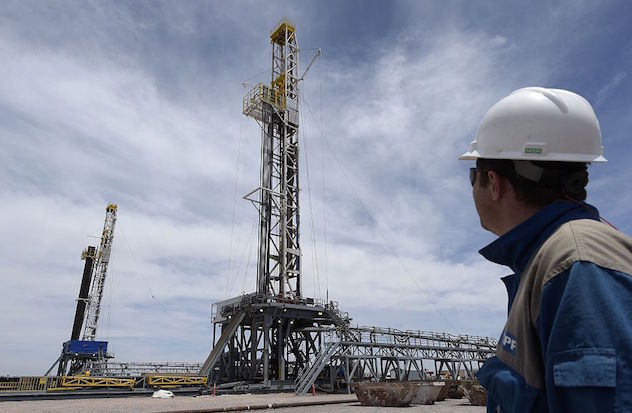Benjamin N. Gedan and Christopher Phalen’s recent piece for AQ discusses how Mapuche indigenous communities in Argentina are becoming more assertive about reclaiming their ancestral lands, which could derail plans to develop the country’s shale gas and oil reserves.
The article frames the development of Argentina’s shale reserves as crucial to the government’s efforts to accelerate growth. Indeed, Argentina has the second-largest shale gas reserves in the world and the fourth-largest reserves of tight oil, and President Mauricio Macri has prioritized attracting foreign investment to the sector. The government wants to end Argentina’s reliance on foreign energy and achieve self-sufficiency by 2022. It is also interested in becoming a leading exporter of liquefied natural gas. To this end, it is boosting the supply of domestic natural gas and increasing renewable energy capacity. These topics and others will be discussed at the G20’s Energy Transitions Working Group meeting in Buenos Aires on Feb. 22 and 23.
That said, Gedan and Phalen’s article omits several important issues that merit discussion: Argentina’s commitments under the Paris Agreement to reduce its emissions and the global carbon budget; climate risks, including the threat of stranded assets and growing divestment from fossil fuels; and the potential benefits from a greater emphasis on renewable energy, storage and efficiency measures.
First, Argentina is ripe for developing its renewable energy potential, and it is already making progress. While less than 2 percent of the country’s electricity comes from renewable energy, a law passed in 2016 sets an 8 percent target for renewable electricity consumption by 2018 and 20 percent by 2025. Last year, Argentina attracted $1.8 billion in clean energy investment up 777 percent on 2016.
Argentina backs the Paris Agreement and its goal of limiting global warming to well below 2 degrees Celsius. To stand any chance of meeting that goal, global emissions must peak by 2020 and then drop. A great portion of the fossil fuel reserves on the books of listed and national companies must therefore be considered unburnable – up to 80 percent of publicly listed fossil fuel reserves, according to the Carbon Tracker Initiative. In Latin America, about 42 percent of oil, 56 percent of gas and 73 percent of coal reserves are estimated to be unburnable before 2050 without carbon capture and storage, according to a study in Nature. This includes Argentina’s shale reserves, which alongside other major reserves, would gobble up the remaining carbon budget.
Gedan and Phalen also report that billions of dollars in investment are flowing to Vaca Muerta. Yet there is no discussion of the risks posed to the global economy by an overly exposed industry. Investors increasingly fear that a failure to consider climate risks could affect economic and financial stability if fossil fuel assets become stranded after suffering premature or unanticipated write-downs or losses.
There are serious transition risks for the energy sector globally. Fossil fuels could become less competitive because of policies to reduce emissions, or due to the continuing reduction in the cost of renewable energy and battery storage. Research suggests that the global fossil fuel industry could lose $28 trillion in revenues over the next two decades as share prices fall due to a decrease in the price of fossil fuels, and demand declines as climate policies such as carbon pricing and energy efficiency measures are implemented.
Various actors are having a rethink. Last year, the World Bank Group announced that it will no longer finance upstream oil and gas after 2019. France’s parliament approved a law banning all exploration and production of oil and natural gas within the country and its overseas territories by 2040. Last month, New York City announced a goal of divesting its $189 billion pension funds from fossil fuel companies within five years.
There is also growing interest in disclosing information about the risks and opportunities presented by climate change. The G20-backed Task Force on Climate-Related Financial Disclosure created recommendations to support investors interested in getting information to assess whether a company’s activities are consistent with the Paris Agreement. Shareholders of ExxonMobil, a major player in Argentina, approved a measure requiring increased transparency on how policies related to implementing the Paris Agreement and technology change could impact business.
There is also scant treatment in Gedan and Phalen’s piece about to the extent to which natural gas can be considered a “clean fossil fuel.” When burned, it releases significantly less carbon dioxide than coal. In the U.S., the shale gas revolution was credited with a reduction in carbon emissions. However, data shows there have been huge leaks of methane throughout the gas supply chain. A NASA study confirms that the oil and gas industry is largely responsible for the global rise in methane emissions, which is a considerably more potent greenhouse gas than carbon dioxide.
Furthermore, Oil Change International says that exploiting gas is incompatible with the Paris Agreement even if the methane leaks are plugged. With vast sums flowing to Vaca Muerta, Argentina runs the risk of becoming locked into a fossil fuel infrastructure, and its related emissions, for decades. Huge investments in power plants and pipelines require decades of operation to become profitable; investors would suffer if forced to retire these assets early.
As Gedan and Phalen show, much is a stake for Argentina’s energy sector in its quest for investment and self-sufficiency. Under the Paris Agreement, Argentina has pledged to cut its emissions, and yet, energy-related emissions are projected to increase by about 60 percent between 2010 and 2030. The energy sector represents over 40 percent of Argentina’s emissions.
Meanwhile, Argentina is one of the windiest and sunniest places in the world, with a potential for wind and solar power that has scarcely been tapped. Renewable energy has many advantages over fossil fuels as a low-emission energy source, but also as an increasingly competitive one as the price of technology falls. Without the hefty climate risks associated with fossil fuels, renewable energy is also a much safer investment especially when combined with advances in battery storage and energy efficiency measures.
Argentina’s shale oil and gas development is at an early stage. Taking into account the specter of climate risks and their possible costs, but also the awesome potential for renewables, a rethink is still possible. Given the accusations being levelled against the Argentine government and foreign companies of trampling on the rights of the indigenous peoples in shale development areas, affected communities, including the Mapuche, might well prefer this option too.
—
Edwards is a co-director of the Climate and Development Lab at Brown University.






